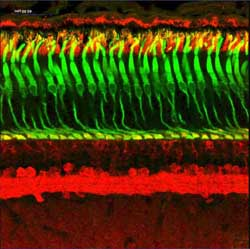A New Therapeutic Trick for Old Dogs
Eye On the Cure Research News
Get updates on Eye On the Cure Research News
An image of a retina, courtesy of courtesy of Dr. Nicolás Cuenca, University of Alicante.
A Foundation-funded research team at the University of Pennsylvania — in collaboration with scientists from Michigan State University, the University of Florida and the University of Miami — has found a remarkable way to restore function to fledgling cones, the retinal cells most critical to our daily lives. Drs. András Komáromy and Gutavo Aguirre injected a high dose of a protein called ciliary neurotrophic factor (CNTF) into the eyes of older dogs with achromatopsia, a retinal disease that causes day blindness from cone dysfunction and degeneration. What happened next is extraordinary.
The CNTF caused the cones to deconstruct, regenerate and come back even stronger, so that they were able to transiently provide day vision. Specifically, the cones grew new and more robust outer segments, the antennae-like projections that process light to make vision possible.
The Pennsylvania team came up with this innovative approach because it was having problems with a gene therapy it had developed for achromatopsia caused by mutations in the CNGB3 gene. The therapy worked well in younger dogs, but not in canines older than one year. However, the injection of CNTF prior to the gene therapy proved to be an effective solution to the problem.
You may be asking: Will this restorative approach work for rods, the cells that provide night and peripheral vision, or other diseases, such as retinitis pigmentosa (RP)? Can photoreceptor deconstruction and regeneration be a new cross-cutting therapeutic approach?
While these are distinct possibilities, much more research is needed to determine CNTF's potential. Deconstructing a photoreceptor to resurrect it is still scientifically bold. Before we move this type of therapy into humans, we want to have a reasonable level of confidence that photoreceptors will be regenerated by the process. It is also important to demonstrate that cone restoration can last longer than it currently is.
Those of you who have been following Foundation-funded research may already be familiar with CNTF. It's the therapeutic protein delivered by Neurotech's encapsulated cell technology (ECT), a tiny implantable device the size of a pencil head. But the amount of protein diffused by the ECT is a relatively low dose that is thought to be only protective; it isn't enough for cone destruction and regeneration.
Results from clinical trials of ECT suggested that it was slowing vision loss for people with dry age-related macular degeneration. It also appeared to have a beneficial effect on retinal health for people with inherited retinal diseases such as RP and Usher syndrome.
Human studies of ECT continue. The Foundation is funding an imaging study of ECT at the University of California, San Francisco, to better understand its true potential for saving cones and vision. The National Eye Institute is also conducting an ECT clinical trial, interestingly enough, for people with achromatopsia, but as a protective therapy.
As I've said in previous blog posts, science is always full of surprises, and CNTF is a prime example. Its potential applications — in both low and high doses — are very intriguing.
One final observation: Whoever came up with the adage, "You can't teach an old dog new tricks," never met a researcher funded by the Foundation.




